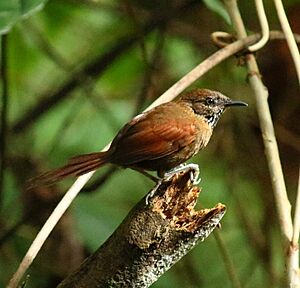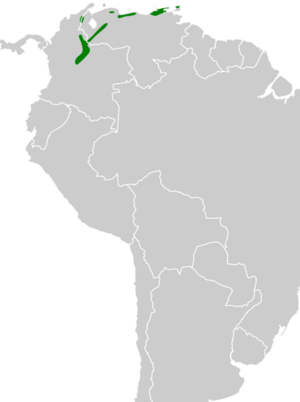Stripe-breasted spinetail facts for kids
Quick facts for kids Stripe-breasted spinetail |
|
|---|---|
 |
|
| Conservation status | |
| Scientific classification | |
| Genus: |
Synallaxis
|
| Species: |
cinnamomea
|
 |
|
The stripe-breasted spinetail (Synallaxis cinnamomea) is a small passerine bird, which means it's a type of songbird. It belongs to the ovenbird family called Furnariidae. You can find this bird in Colombia, Trinidad, Tobago, and Venezuela. It's known for its unique striped chest and a tail that looks a bit spiny.
Contents
About This Bird's Family
The stripe-breasted spinetail is part of a group of birds called Synallaxis. There are seven slightly different types, or subspecies, of the stripe-breasted spinetail. These different types have small variations in their looks or where they live.
Different Types of Spinetails
Here are the seven subspecies:
- S. c. carri
- S. c. terrestris
- S. c. cinnamomea
- S. c. aveledoi
- S. c. bolivari
- S. c. striatipectus
- S. c. pariae
The stripe-breasted spinetail is closely related to other spinetails, like the ruddy spinetail and the chestnut-throated spinetail.
What Does It Look Like?
The stripe-breasted spinetail is about 14 to 16 cm (5.5 to 6.3 in) long. That's about the length of a pen. It weighs between 15 to 23 g (0.53 to 0.81 oz), which is lighter than a few coins. It has one of the shortest tails in its bird group. Both male and female birds look very similar.
Colors and Markings
Adult birds usually have a brownish-red face with a faint pale stripe above their eye. Their head, back, and rump are a rich brown color. Their wings are a reddish-brown with dark tips on the flight feathers. Their tail is also rich brown and looks a bit spiny because the ends of the feathers don't have full barbs.
Their throat has black stripes on a white background. Their belly is lighter, and their chest has reddish-brown streaks. The color of their eyes can be reddish, creamy brown, or dark brown. Their beak is dark, and their legs and feet are dark gray to black. Young birds are usually browner than adults. Their throat stripes and belly streaks are also less clear.
How Subspecies Differ
The different subspecies have slight variations in their colors:
- S. c. carri: Has darker brown upper parts and dull olive-brown underparts with faint streaks.
- S. c. terrestris: Is the palest of all the subspecies. Its upper parts are more olive-brown, and its underparts are mostly plain.
- S. c. striatipectus: Has darker upper parts, reddish-brown wings and tail. It also has a clear buff stripe above its eye and strong black streaks on its chest.
Some scientists think that the S. c. bolivari subspecies might even be a separate species because it looks quite different from the others.
Where Does It Live?
The stripe-breasted spinetail lives in different areas that are not connected. This is called a disjunct distribution.
Locations of Subspecies
- S. c. carri: Lives on the island of Trinidad.
- S. c. terrestris: Lives on the island of Tobago.
- S. c. cinnamomea: Found along the border of Venezuela and Colombia, and in parts of Colombia's Andes mountains.
- S. c. aveledoi: Lives in the Andes mountains of western Venezuela and into northern Colombia.
- S. c. bolivari: Found in the coastal mountains of Venezuela.
- S. c. striatipectus: Lives in northeastern Venezuela.
- S. c. pariae: Found on the Paria Peninsula in northeastern Venezuela.
Preferred Homes
On the mainland of South America, these birds live in many types of places. They like subtropical and tropical forests where trees lose their leaves. They also live in forests along rivers and in dry mountain areas with scrubby bushes. You can also find them in the undergrowth of tropical lowland forests and even in old coffee farms.
On Trinidad and Tobago, they mostly live in the undergrowth of forests. They can be found at different heights, from 800 to 3,100 m (2,600 to 10,200 ft) in Colombia and 700 to 2,000 m (2,300 to 6,600 ft) in Venezuela.
Behavior and Life Cycle
The stripe-breasted spinetail stays in the same area all year round. It does not migrate.
What It Eats
This bird eats arthropods, which are creatures like insects and spiders. It usually hunts for food in pairs. Sometimes, it joins groups of different bird species that are also looking for food. It finds its prey by picking it off leaves and branches up to about 2 m (7 ft) above the ground. It also searches for food in the leaf litter on the ground.
Reproduction and Nests
Even though it's called an "ovenbird" (because many birds in its family build nests that look like ovens), the stripe-breasted spinetail builds a different kind of nest. It makes a round nest out of sticks and leaves. This nest has a tunnel-like entrance on top. It can build its nest on sloping ground or in a bush, up to about 3 m (10 ft) above the ground.
On Trinidad, they can breed at any time of the year. On Tobago, they breed at least between March and August. Each nest usually has three eggs. We don't know how long the eggs take to hatch or when the young birds leave the nest. We also don't know much about how the parents care for their young.
Sounds It Makes
The stripe-breasted spinetail's song has two notes. The second note is lower but then rises. It sounds like a "chík-kweek" or "chúrt-wert" and is often repeated for a long time. Its calls are soft, whining sounds like "peeeur" or "chew".
Conservation Status
The IUCN (International Union for Conservation of Nature) has listed the stripe-breasted spinetail as a species of Least Concern. This means it is not considered to be in danger of extinction. It lives across a large area, and even though we don't know the exact number of birds, its population is thought to be stable.
There are no immediate threats to this bird. It is quite common in Colombia and very common on Trinidad, Tobago, and the Paria Peninsula. It lives in several protected areas and seems to do well in forested areas that have been opened up by cutting trees.


